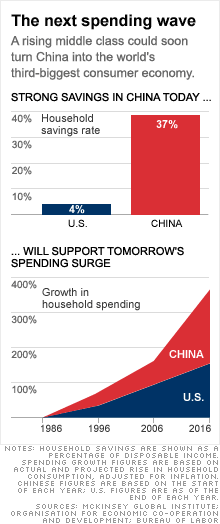Get ready for an Asian spending wave
Money's stock strategist thinks this region of savers could soon become one of spenders. Here's what it means for you.

(Money Magazine) -- You've seen what happens when the world's biggest spenders - American consumers - start to save more and shop less. The results, economically speaking, aren't very pretty. But what would happen if the world's most prodigious savers - Asian households - started to sock away less and spend more?
On a recent trip to Asia, including stops in China, Hong Kong, Japan, and Singapore, I spoke to people with deep experience in that part of the world and came away with a sense that this shift could happen sooner than many assume. And if it does, it would unleash a wave of growth transforming the region and creating a great opportunity for U.S. investors.
Americans actually deserve some of the credit for Asia's savings rates. For years we've been sending U.S. dollars there in exchange for low-cost manufactured goods. But instead of spending the money, households there salted it away, creating one of the world's largest pools of untapped capital.
In China, for example, families now save more than a third of their disposable income (see the chart), which explains why consumer spending accounts for just 35% of that nation's economy vs. 71% in the U.S.
What makes me think this is likely to change? For starters, it's happened before. South Koreans went from saving a quarter of their disposable income a decade ago to socking away just 4% today.
And other countries are nudging their consumers in this direction. Asian officials realize that as spending in the U.S. slows, their citizens must pick up some of the slack.
China, for example, announced a massive plan to improve its health-care system that will indirectly stimulate consumers. How? Health care in this Communist country, ironically, is largely cash-and-carry - meaning, if you have the cash, you get care. This is a big reason Chinese families save so much, surveys show. If the government picks up more of this tab, families may not feel the need to sit on their savings.
Also, there's a psychological component. Just as Americans went from savers to spenders only after memories of the Great Depression faded, Asian households are now more than a decade removed from the currency crisis that rocked the region in the late '90s.
If this transition takes place soon, how can you take advantage of it?
Broaden your horizons. If you own a foreign fund that tracks the EAFE index, about a quarter of your money is in Asia - but almost all of that is in slow-growing Japan. That's hardly a bet on this spending wave.
As an alternative, you can add a modest stake to an Asia fund like Matthews Pacific Tiger, which favors firms that are benefiting from domestic consumption. But an emerging-markets portfolio is a long-term holding that can easily blow up in the short run. So if you decide to go this route, dollar-cost average into such funds.
Focus on service providers. For example, as leisure spending grows, Chinese transportation expenditures are expected to grow 1,400% between 2005 and 2025, according to a McKinsey study. If you have a stomach for risk, you could invest in Chinese firms that stand to benefit from this trend, like Ctrip.com (CTRP), China's dominant online travel site.
Or if you want to play it safer, focus on the few U.S. firms that are getting most of their incremental growth from Asia, such as Yum Brands (YUM, Fortune 500). Its KFC restaurants are big in China, and Yum is getting more than 70% of incremental profits from its Chinese operations.
Of course, Yum isn't a conventional Asian play. Then again, once this spending materializes, conventional wisdom about investing in this region will no longer apply. ![]()


